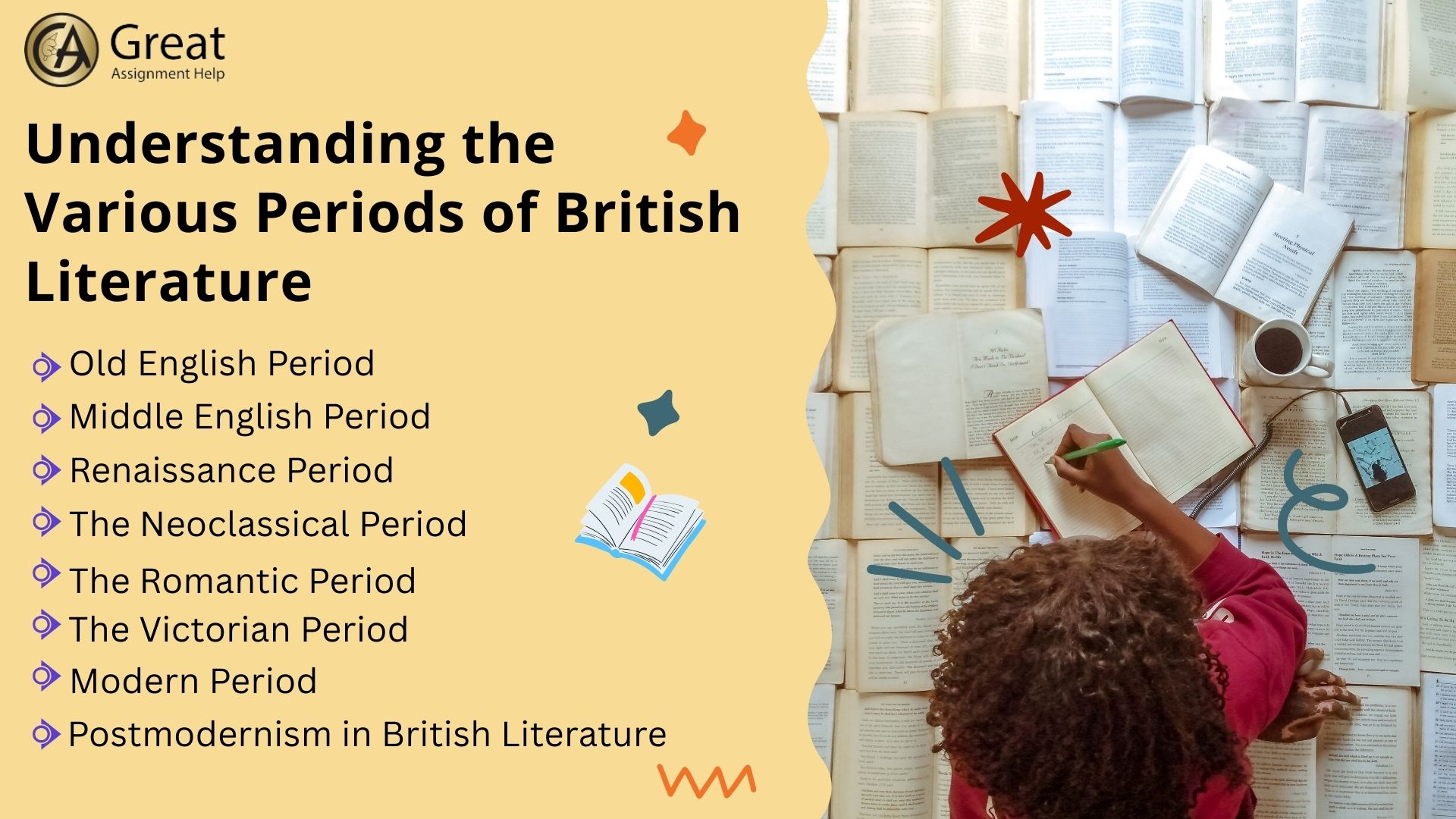British literature has a long and varied history. From the Renaissance to Postmodernism, the periods of British Literature have distinct styles and characteristics. By exploring these periods, you can gain a deeper understanding of the country’s rich literary identity and the authors who shaped it.
British literature is one of the renowned literary traditions in the world. It comprises written text in the form of poetry, drama, and prose by the UK-based authors. British literature has its origin in the 5th century, and it has influenced English literature while inspiring writers throughout the globe. Charles Dickens, George Eliot, and Jane Austen are some of the popular authors who have contributed a lot to British literature. No matter whether you are a student or a book lover, the evolution of British literature will excite you the most. If you wish to learn about the different periods in British literature, then read this blog. Here, you will get a complete overview of British literature and its history.
What is British Literature?
British Literature is a very old form of literature that originates from the United Kingdom. Primarily, it reflects the country’s society and culture over time. Overall, British Literature has played a big role in shaping literary standards and education in countries where English is spoken. British literature spans a long period and is divided into nine distinct periods. Each period typically shows what life was like in Britain at that time. By exploring these periods, you can see how Britain’s society and culture have evolved.
Understanding the Various Periods of British Literature

Here, let us explore the key divisions of British Literature in various periods
Old English Period
The Anglo-Saxon Period, or the Old English Period, is one of the oldest periods of English literature. The period is characterized by epic poems. One of the best-known works during this period is the poem “Beowulf”. Some other notable poems of this era are “The Battle of Brunanburh” and “The Battle of Maldon”. Usually, the old English literature includes descriptions of sermons, saints’ lives, Bible translations, historical works, and legal documents. There are over 400 manuscripts from this period, but only about 189 are considered very important.
The earliest known poem of this period is Caedmon’s hymn. It was composed in the 7th century. Compared to this, “The Grave” is the most recent poem composed in the old English style. Although many authors from this period are unknown, their works remain well-known today.
Some popular literary works from the Anglo-Saxon period include “The Wife’s Lament”, “The Seafarer”, “The Wanderer”, “The Exeter Book”, and “The Anglo-Saxon Chronicle”.
Middle English Period
The Middle English period in British literature lasted from the 14th century to around 1470. During this era, a significant shift happened in culture and language. Moreover, in this period, the printing press started using the English spoken in London as the standard language for publishing. This change was brought by the country’s high culture and legislators. The principal themes of Middle English literature were Christianity, ethics, courtly love, human nature, and tales of King Arthur.
Multiple authors wrote during the literature of this time, but because of poor records, few of their writings are popular today. The Middle English period is categorized into three phases like Early Middle English, Central Middle English, and Late Middle English.
Geoffrey Chaucer, a leading narrative poet from the Middle English era, is referred to as the father of English poetry. His writings, such as “The Canterbury Tales” and “Troilus and Criseyde”, remain popular even in the present day. Some other works of this period are “Sir Gawain and the Green Knight”, “Piers Plowman”, and “The Book of the Duchess”.
Renaissance Period
The Renaissance, or “rebirth,” was a cultural movement that began in Italy during the 14th century. This era is renowned for its amazing art, literature, and scientific achievements. Most of the popular writers have contributed heavily in this era. It is therefore regarded as one of the golden ages of British literature.
The Renaissance period saw major transformations in various fields, including science, global connections, and religious beliefs. Especially during this era, new forms of literature were introduced, and authors also explored themes like humanism, religion, and politics. A few of the popular writers from this era are William Shakespeare, Leonardo Da Vinci, and Galileo.
These are the four phases of the Renaissance era in British literature
Early Renaissance (pre-Elizabethan period): This era saw the rise of poetry and prose. Authors like Thomas More and Thomas Wyatt were prominent figures during this time.
Elizabethan Period: It was a golden age for English drama. Most prominent playwrights and writers rose to fame during this era.
Jacobean Era: This age began when King James I took the throne, and he is notable for his bible translation. Notable writers such as Shakespeare and John Donne were extremely successful then.
Caroline and Commonwealth Era: This period saw the rise of authors like John Milton and Robert Burton. However, theater and drama declined during this time because the Puritans closed all the theaters.
The Neoclassical Period
The Neoclassical period came after the Renaissance period and focused on using literature to teach and improve society. During this period, Authors like John Dryden, Alexander Pope, and Jonathan Swift wrote works that showcased societal hypocrisy and explored personal desires. Examples of their writing include “Absalom and Achitophel,” “Gulliver’s Travels,” and “The Vicar of Wakefield.” Specifically, in the neo-classical period, authors like Goldsmith had started to express emotions in their work.
Neoclassical literature prioritizes rational thinking over imagination. It often uses satirical poetry to critique society and expose foolishness. Also, it features realistic portrayals of society and highlights harsh realities.
These are the three divisions of the neoclassical period:
The Restoration Period: Satire was favored during this period, and authors such as John Bunyan and Aphra Behn were well-known.
Augustan Age: During this period, writers such as Swift and Pope borrowed classical forms.
Age of Sensibility: During this time, Writers such as Samuel Richardson and Henry Fielding were known.
The Romantic Period
The start of the Romantic era is believed to have begun around 1785, after the Age of Sensibility. In this era, Romantic authors moved away from reason and spoke about the senses, feelings, imagination, and nature. Also, they rejected rationalism in their work.
Romantic literature prioritizes imagination and feelings over rational thinking, with a focus on nature, the medieval past, and supernatural themes. It also explores melancholy, psychology, sadness, death, and human emotions.
Some of the well-known Romantic authors are William Wordsworth, Samuel Taylor Coleridge, and William Blake. A few other famous Romantic poets belonging to the second generation are Lord Byron, Shelley, and John Keats.
The Victorian Period
The Victorian period began in 1837 when Queen Victoria took the throne and lasted until she died in 1901. During this time, writers addressed various social, religious, and economic issues in their work. The key features of Victorian literature include Victorian Realism, Utilitarianism, and Agnosticism.
These are the three stages of the Victorian period:
The Early Victorian period (1832-1848) experienced the Industrial Revolution and had authors such as Charles Dickens and Charlotte Bronte.
The Mid-Victorian period (1848-1870) characterizes prosperity and focuses on religion and faith. Charles Dickens and George Eliot were popular writers during this time.
The Late Victorian period (1870-1890) experienced popular experimental literature. Oscar Wilde and Thomas Hardy were the most notable contributors during this time.
Modern Period
The Modern era of literature started with World War I. During this era, writers started experimenting with new styles and subjects by using techniques like verse writing, narrative, and drama. Novels like “Things Fall Apart” reflect modernist elements.
Some notable authors of the Modern Age include:
- Novelists like James Joyce, D.H. Lawrence, Dorothy Richardson, E.M. Forster, and Doris Lessing
- Poets like W.B. Yeats, W.H. Auden, Seamus Heaney, and Wilfred Owen
- Playwrights like George Bernard Shaw
Postmodernism in British Literature
Postmodernism in British literature started around 1939 and continues to the present day. This movement gained momentum after World War II. Writers of this era experimented with new literary devices, forms, and styles and explored themes like subjectivity, memory, and anxiety.
Some notable writers of this period include:
- Novelists like Evelyn Waugh, Graham Greene, and Julian Barnes
- Playwrights like Harold Pinter and Samuel Beckett
- Poets like Philip Larkin
- Other notable writers such as Joseph Heller, Luigi Pirandello, and Bertolt Brecht
Wrapping Up
British literature is a fascinating subject that explores the history of literature. While it can be motivating, it also requires more reading and dedication to understand the concepts and write the assignments. If it is challenging for you to do your literary assignments, call us for support. The literary experts from our team will offer you the best English literature assignment help online at affordable prices so you can improve your subject comprehension and achieve top grades.



